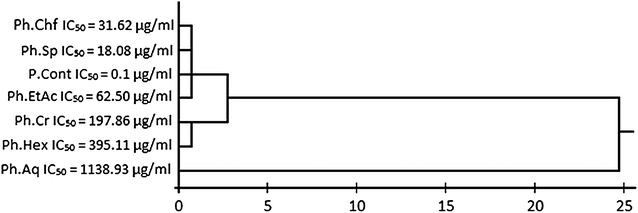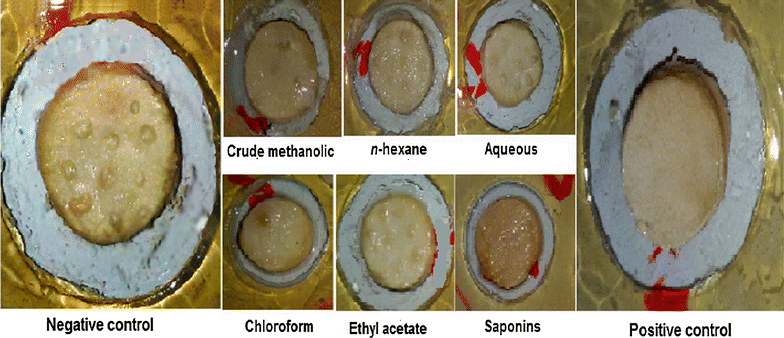Antitumor and anti-angiogenic potentials of isolated crude saponins and various fractions of Rumex hastatus D. Don
- PMID: 26969307
- PMCID: PMC4788867
- DOI: 10.1186/s40659-016-0079-2
Antitumor and anti-angiogenic potentials of isolated crude saponins and various fractions of Rumex hastatus D. Don
Abstract
Background: Cancer, being the foremost challenge of the modern era and the focus of world-class investigators, gargantuan research is in progress worldwide to explore novel therapeutic for its management. The exploitation of natural sources has been proven to be an excellent approach to treat or minify the excessive angiogenesis and proliferation of cells. Similarly, based the ethnomedicinal uses and literature survey, the current study is designed to explore the anti-tumor and anti-angiogenic potentials of Rumex hastatus. Anti-tumor and anti-angiogenic activities were carried out using potato-disc model and chorioallantoic membrane (CAM) assay respectively. Moreover, R. hastatus was also assessed for antibacterial activity against Agrobacterium tumefaciens (tumor causing bacterial strain). The positive controls used in anti-tumor, anti-angiogenic and antibacterial activities were vincristine sulphate, dexamethasone and cefotaxime respectively.
Results: The crude saponins (Rh.Sp), methanolic extract (Rh.Cr) and other solvent extracts like n-hexane (Rh.Hex), chloroform (Rh.Chf), ethylacetate (Rh.EtAc) and aqueous fraction (Rh.Aq) exhibited notable anti-tumor and anti-angiogenic activities. In potato tumor assay, the chloroform and saponin fractions were observed to be the most effective showing 86.7 and 93.3 % tumor inhibition at 1000 µg/ml with IC50 values 31.6 and 18.1 µg/ml respectively. Similarly, these two samples i.e., chloroform and saponins also excelled among the entire test samples in anti-angiogenic evaluation exhibiting 81.6 % (IC50 = 17.9 µg/ml) and 78.9 % (IC50 = 64.9 µg/ml) at 1000 µg/ml respectively. In contrast, the antibacterial investigations revealed a negligible potential against A. tumefaciens.
Conclusion: Based on our results we can claim that R. hastatus possesses both anti-tumor and anti-angiogenic potentials. In all of the solvent fractions, Rh.Chf and Rh.Sp were most effective against tumor and angiogenesis while having negligible activity against A. tumefaciens. It can be concluded that Rh.Chf and Rh.Sp might be potential targets in the isolation of natural product having anti-neoplastic action.
Keywords: Agrobacterium tumefaciens; Angiogenesis; Rumex hastatus; Saponins; Tumor.
Figures





References
-
- Rao K, Sunitha C, Banji D, Shwetha S, Krishna D. Diuretic activity on different extracts and formulation on aerial parts of Rumexvesicarius Linn. J Chem Pharm Res. 2011;3(6):400–408.
-
- Folkman J. The role of angiogenesis in tumor growth. Semin Cancer Biol. 1992;1992:65–71. - PubMed
-
- Losso JN. Targeting excessive angiogenesis with functional foods and nutraceuticals. Trends Food Sci Technol. 2003;14(11):455–468. doi: 10.1016/S0924-2244(03)00156-0. - DOI
Publication types
MeSH terms
Substances
LinkOut - more resources
Full Text Sources
Other Literature Sources

